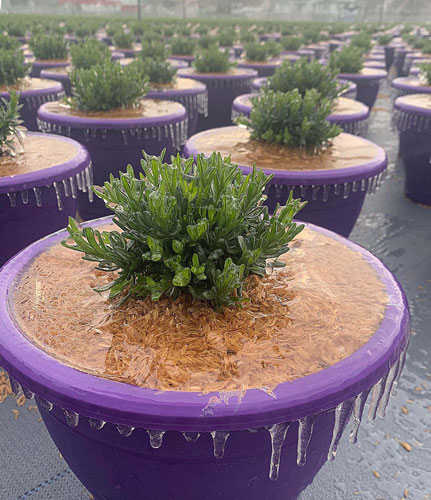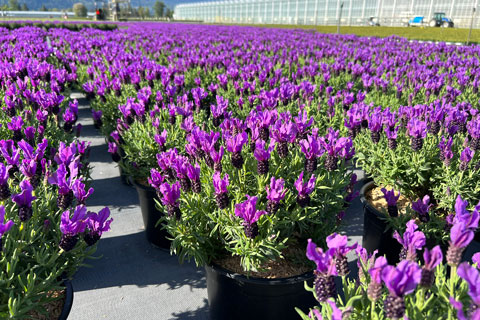6/1/2024
Growing Against the Rain: Lavandula Tech Tips
Stephanie Saccomano

Lavender, cherished for its aromatic properties and pop of colorful flowers, naturally thrives in the dry, sunlit environments of the Mediterranean—not in the damp and often dark conditions of the Pacific Northwest. Despite these adversities, it is indeed possible to cultivate lavender successfully by thoroughly understanding the plant's needs. We can have up to 100 varieties on site so we can learn a little more every year. Where there’s a will (and occasionally a good pair of gumboots) there’s a way to make lavender feel at home even in the drizzle. From Qualitree to you, we’re sharing some variables you can control to ensure your plants thrive—even if you’re growing them in one of the worst places in the world to do so.
Pictured: Lavender frost protection.
Consider your conditions: Here, at home base, we’ve been working to create as close to an ideal environment as we can. As an example, we all know Lavandula are lovers of light. This isn’t something we have in spades at Qualitree, especially nestled under a mountain in the dark hours of winter. But quantitatively, what does this mean? It’s only by measuring the Daily Light Integral (DLI) within our structures and outdoors that we truly understand what we may be lacking. We can observe that during the spring and summer we have adequate light levels, meaning we’ll lean hard on those free photons and focus the majority of production requirements here. In the darker seasons, where active growth may still be necessary, we know that supplemental lighting is a must.
An important facet to the topic of light is temperature. Maintaining a balance of temperature and light ensures strong growth. If light is low and temperatures are cranked to encourage development, you’ll find yourself with soft, pale and stretched foliage that’s susceptible to disease. Additionally, you could end up with aborted buds or strictly vegetative growth. Locations with more light have the opportunity to apply more temperature. Playing this balance out practically could mean reducing your temperatures over dark or cloudy weeks, and toning your venting strategy to lock in energy during high light situations. If growing outside, understanding these concepts and watching the weather will help you anticipate the behavior of your crop.
Additionally, if you have the means to protect your plants from moist or frosty conditions, do so. Protective structures that allow for plenty of airflow and ventilation are perfect. This space can also be very helpful in insulating against any frost threats in the shoulders of winter. If this is a luxury you don’t have and you’re facing a hard frost in the forecast (as is the case with us at times), sprinkling pulses of water for frost protection will be your best bet. Your plant will be safe, but you do add another stressor: more moisture, which is a perfect segue to …
 Mind your roots: Lavender doesn’t take kindly to wet feet, therefore careful water management is crucial; overwatering can lead to fungal diseases and weak root systems. An absolute must is a well-draining substrate that alleviates moisture pressures at the roots. Equally important is avoiding over-fertilization, particularly with nitrogen, which can promote soft, weak growth that attracts pests and succumbs easily to diseases. Balanced fertilizers are best to support steady, resilient growth. We incorporate a small quantity of slow-release fertilizer into our substrates and rely on fertigation for the majority of the crop’s nutrition.
Mind your roots: Lavender doesn’t take kindly to wet feet, therefore careful water management is crucial; overwatering can lead to fungal diseases and weak root systems. An absolute must is a well-draining substrate that alleviates moisture pressures at the roots. Equally important is avoiding over-fertilization, particularly with nitrogen, which can promote soft, weak growth that attracts pests and succumbs easily to diseases. Balanced fertilizers are best to support steady, resilient growth. We incorporate a small quantity of slow-release fertilizer into our substrates and rely on fertigation for the majority of the crop’s nutrition.
Pictured: A flowering lavender crop at Qualitree.
Biostimulants and resilience boosters: Natural biostimulants or foliar fertilizers such as calcium, silica products and seaweed extracts can strengthen plant cells and enhance overall vitality, preparing lavender to better withstand conditions that may be beyond your control. These products support the plant’s natural defenses, promoting growth that’s both vigorous and disease resistant. A go-to when we know we’re facing humid conditions are calcium foliar applications. In these situations, transpiration (and therefore calcium uptake) is inhibited and can lead to tip discoloration or die-back.
While growing lavender in the Pacific Northwest may initially seem like a horticultural folly, the reality is far more rewarding. By giving this plant every opportunity to thrive, we can indeed create a slice of the Mediterranean in our corner of the world—and you likely can, too. GT
Stephanie Saccomano is Production Technical Lead and Simon Traskey is Technical Advisor for Qualitree in Rosedale, British Columbia, Canada.